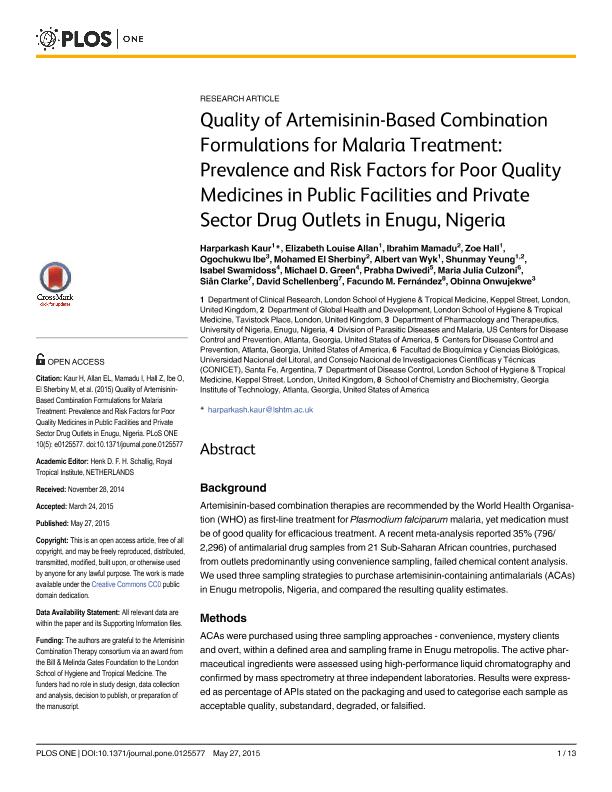Artículo
Quality of artemisinin-based combination formulations for malaria treatment: Prevalence and risk factors for poor quality medicines in public facilities and private sector drug outlets in Enugu, Nigeria
Kaur, Harparkash; Allan, Elizabeth Louise; Mamadu, Ibrahim; Hall, Zoe; Ibe, Ogochukwu; El Sherbiny, Mohamed; Van Wyk, Albert; Yeung, Shunmay; Swamidoss, Isabel; Green, Michael D.; Dwivedi, Prabha; Culzoni, Maria Julia ; Calrke, Sian; Schellenberg, David; Fernández, Facundo M.; Onwujekwe, Obina
; Calrke, Sian; Schellenberg, David; Fernández, Facundo M.; Onwujekwe, Obina
 ; Calrke, Sian; Schellenberg, David; Fernández, Facundo M.; Onwujekwe, Obina
; Calrke, Sian; Schellenberg, David; Fernández, Facundo M.; Onwujekwe, Obina
Fecha de publicación:
05/2015
Editorial:
Public Library of Science
Revista:
Plos One
e-ISSN:
1932-6203
Idioma:
Inglés
Tipo de recurso:
Artículo publicado
Clasificación temática:
Resumen
Background Artemisinin-based combination therapies are recommended by the World Health Organisation (WHO) as first-line treatment for Plasmodium falciparum malaria, yet medication must be of good quality for efficacious treatment. A recent meta-analysis reported 35% (796/ 2,296) of antimalarial drug samples from 21 Sub-Saharan African countries, purchased from outlets predominantly using convenience sampling, failed chemical content analysis. We used three sampling strategies to purchase artemisinin-containing antimalarials (ACAs) in Enugu metropolis, Nigeria, and compared the resulting quality estimates. Methods ACAs were purchased using three sampling approaches - convenience, mystery clients and overt, within a defined area and sampling frame in Enugu metropolis. The active pharmaceutical ingredients were assessed using high-performance liquid chromatography and confirmed by mass spectrometry at three independent laboratories. Results were expressed as percentage of APIs stated on the packaging and used to categorise each sample as acceptable quality, substandard, degraded, or falsified. Results Content analysis of 3024 samples purchased from 421 outlets using convenience (n=200), mystery (n=1,919) and overt (n=905) approaches, showed overall 90.8% ACAs to be of acceptable quality, 6.8% substandard, 1.3% degraded and 1.2% falsified. Convenience sampling yielded a significantly higher prevalence of poor quality ACAs, but was not evident by the mystery and overt sampling strategies both of which yielded results that were comparable between each other. Artesunate (n=135; 4 falsified) and dihydroartemisinin (n=14) monotherapy tablets, not recommended by WHO, were also identified. Conclusion Randomised sampling identified fewer falsified ACAs than previously reported by convenience approaches. Our findings emphasise the need for specific consideration to be given to sampling frame and sampling approach if representative information on drug quality is to be obtained.This is an open access article, free of all copyright, and may be freely reproduced, distributed, transmitted, modified, built upon, or otherwise used by anyone for any lawful purpose. The work is made available under the Creative Commons CC0 public domain dedication.
Archivos asociados
Licencia
Identificadores
Colecciones
Articulos(CCT - SANTA FE)
Articulos de CTRO.CIENTIFICO TECNOL.CONICET - SANTA FE
Articulos de CTRO.CIENTIFICO TECNOL.CONICET - SANTA FE
Citación
Kaur, Harparkash; Allan, Elizabeth Louise; Mamadu, Ibrahim; Hall, Zoe; Ibe, Ogochukwu; et al.; Quality of artemisinin-based combination formulations for malaria treatment: Prevalence and risk factors for poor quality medicines in public facilities and private sector drug outlets in Enugu, Nigeria; Public Library of Science; Plos One; 10; 5; 5-2015; e0125577
Compartir
Altmétricas



